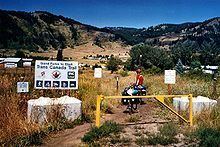Country Canada Regional district Kootenay Boundary Time zone PST (UTC-8) Elevation 520 m Local time Friday 11:32 PM | Incorporated 1897 Postal code V0H Population 4,049 (2016) | |
 | ||
Weather 2°C, Wind E at 5 km/h, 88% Humidity | ||
Grand Forks, population 4,049, is a city in the Boundary Country of the West Kootenay region of British Columbia, Canada. It is located at the confluence of the Granby River and Kettle River, a tributary of the Columbia. The city is just north of the US-Canada border, approximately 500 km from Vancouver, British Columbia and 200 km from Kelowna, British Columbia and 220 km from Spokane, Washington and 23 km west of the resort area of Christina Lake by road.
Contents
Map of Grand Forks, BC, Canada
History
Grand Forks was established in the late 19th century when copper mining dominated Boundary and Kootenay regions of BC. The city was laid out in 1895 and Grand Forks was officially established as a city on 15 April 1897. The adjacent City of Columbia was incorporated on May 4, 1899. By 1900, Grand Forks boasted three railways, lumber mills, a smelter, mines, a post office, a school and a hospital. Grand Forks and Columbia amalgamated in 1903. In 1907, it was the home of a local branch of the Western Federation of Miners.
In both 1908 and 1911, fires leveled the downtown core, mainly due to the number of wood frame buildings and stores. Between the years of 1909 and 1913, a group of pacifist Russian immigrants known as Doukhobors settled in the area because of the fertile farm land. Today, many residents of Grand Forks are descendants of the Doukhobors. In 1991, the CP Railway Co. abandoned the railway through Grand Forks and the former right of way became part of the Trans-Canada Trail. Over the years, Grand Forks has continued to expand in size and now has around 4,000 residents, with another 10,000 in the area.
Government
The City of Grand Forks is represented by a seven-person elected council, with Frank Konrad currently serving as mayor. The incumbent councillors are: Julia Butler, Chris Hammett, Neil Krog, Colleen Ross, Christine Thompson, and Beverly Tripp. Grand Forks currently has six councillors until an upcoming by-election. Provincially, Grand Forks is located in the constituency of Boundary-Similkameen, where it is represented by MLA Linda Larson and federally it is located in the South Okanagan—West Kootenay riding and represented by MP Richard Cannings
Climate
Grand Forks experiences a humid continental climate (Köppen climate classification Dfb) with relatively mild, moderately cold winters and hot summers. Grand Forks has a very similar climate to the Okanagan Valley just to the West, but usually receives slightly colder and snowier winters and slightly hotter Summer temperatures due to being away from any lakes. Daytime highs during the Summer often top 30 °C and surpass 40 °C at least once every ten years. During the winter, the blocking barriers of the Rockies and the Columbia Mountains tend to moderate the climate, but cold Arctic air can penetrate into the city for fairly short periods. Typically Grand Forks has a moderate snow cover from early December to late February, but it can disappear for periods of time, especially during milder winters. Precipitation is higher than many other drier Southern Interior locations, but still fairly low.
The primary vegetation in the Grand Forks area indicates a semi arid climate with Sagebrush, Prickly Pear Cactus, Ponderosa Pine and Douglas-fir. More mountainous tree species such as Lodgepole Pine, Western Larch and Englemann Spruce can be found in shady areas and places near the Kettle River.
Schools
Schools in the region are operated by School District 51 Boundary which has its main office in Grand Forks but also serves Midway, Greenwood, Beaverdell, and Rock Creek.
There are two elementary (Dr. D. A. Perley Elementary School, and John A. Hutton Elementary School) and one secondary school (Grand Forks Secondary School). The District also operates an alternate learning centre in Grand Forks (Walker Development Centre).
Selkirk College, based in Castlegar, British Columbia, has a small community campus in Grand Forks. Established in 1966, Selkirk College is BC's oldest community college and offers over 60 accredited programs. Students studying in Grand Forks have access to a variety of courses at both the High School and College level.
Industry
Major industries in Grand Forks are limited and have become less over the past decade with the loss of major industries such as pope&talbot however the industries in Grand Forks are logging, agriculture, rock wool manufacturing, fabrication (metal) and tourism. The town is close to the site of the former Phoenix copper mine, which closed in 1935. The slag piles on the Granby River just outside town are remnants of a large copper smelting operation. The sawmill in Grand Forks is very small and is operated by Interfor (formerly Pope and Talbot) and ships forest products into the United States via rail. Tourism has died off in Grand Forks due to lack of tourist options, however, it does have a pleasant climate and close proximity to the Okanagan. Christina Lake, which is 20 minutes east of Grand Forks, is home to many resorts and summer homes and its year round population of 1000 swells to 6000 during the Summer. The slag from the piles at the north end of town is owned by Pacific Abrasives, who sells it to the US Navy and ships it by rail to San Diego, California to use for sandblasting ships.
The short-line Grand Forks Railway is based out of Grand Forks. The company owns just 3.5 miles of track, which connects Roxul and Interfor with the Grand Forks Junction at the south end of town. It is the shortest railway in Canada and possibly North America. Train cars then get set to the United States via the Kettle Falls International Railway.
